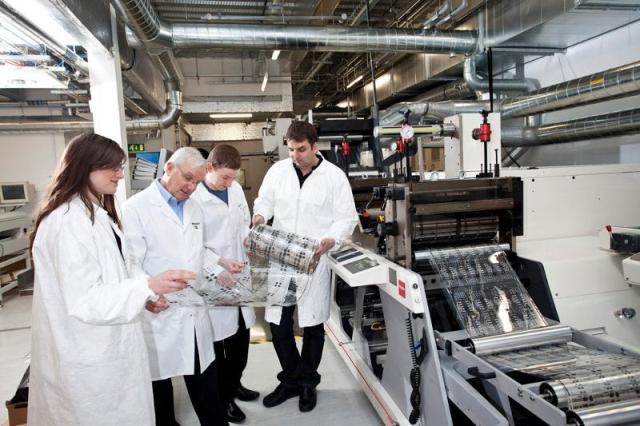Peratech, the innovator in touch technology, has announced that it is working with The Centre for Process Innovation (CPI) to develop new formulations for its award-winning QTC™ materials; the work is supported by government funding as a R&D Technology Strategy Board (TSB) project.
 Staff of Peratech and CPI inspect first run of reel to reel QTC print
Staff of Peratech and CPI inspect first run of reel to reel QTC print
At present, QTC ink formulations are silk-screen printed and they are being used successfully to create pressure sensitive sensors and to print Peratech's innovative QTC Clear touchscreens. The project will establish if existing commercial printing machinery can be used to print a new generation of printable electronics, including QTC sensors, which is a rapidly expanding area of print technology with a clear potential to reduce the weight, component and assembly cost of a vast range of future products.
"The next innovation in electronics is being able to print complete circuit assemblies as this dramatically reduces unit costs," explained David Lussey, Peratech's CTO. "Both active and passive components are being printed onto paper, textiles and plastics using flexographic printing processes. The research project with CPI is designed to create QTC ink formulations that can be used in this and similar printing processes so that QTC pressure sensors and switches can be incorporated into these next generation, printed electronic circuits. The unique properties of QTC materials mean that they are the perfect solution to provide these vital components. We have already proven that QTC materials can be used on textiles and withstand the rigours of washing so the emerging field of flexible and wearable electronics is perfect for our QTC solutions."
Until now, the missing piece of the Printed Electronics jigsaw has been the switches and similar Human Machine Interfaces (HMI) such as touchpads as they typically need structures that cannot be screen printed and are vulnerable to water or dirt ingress getting between contacts. By contrast, QTC switches are solid state with no moving parts giving them a long operational life and robustness against contamination. The QTC switches can be simple on/off or provide a variable response as their resistance changes according to the pressure applied. QTC touchscreens are similarly a solid state film of QTC providing x and y co-ordinate input along with z from the amount of pressure applied. The development of QTC inks that can be printed with standard printing techniques at the same time as the other components will enable the whole field of Printed Electronics to take off by providing this control interface.
The research project with CPI is halfway to completion, with several promising formulations being tested. The first run of printed QTC electronics using a standard flexographic press was successfully done in February this year and signals another quantum leap for Peratech."The beauty of working with CPI is that they have their own development print-line so that new formulations can be tested and feedback is immediately available," added David Lussey. "This is very important as it enables us to experiment with printing the new formulations on different types of materials. For example, in the packaging industry, high quality papers are being developed specifically for printing electronics in applications such as RFID tags, monitoring if use-by dates have been reached, damage monitoring and novelty attention-grabbing features to boost sales."
Apart from printing switches and pressure sensors, Peratech is also researching ways to print its QTC™ E-nose sensors, which can detect volatile organic compounds (VOCs). In these sensors the QTC material expands in the presence of VOCs, changing its resistance and giving very rapid response and recovery times, along with a high level of sensitivity. Different formulations can be made according to the specific VOC to be detected so that low cost warning sensors and the associated electronics can be incorporated into textiles to provide clothing that monitors the wearer for signs of illness, fatigue or exposure to dangerous chemicals.
Nigel Perry, the CEO of CPI added, "We are delighted to be working with Peratech. Its QTC technology is a really exciting area of materials science. Our joint research on QTC print ink for volume printed electronics will open its use up for a huge number of possible applications. We have already shown that printing does not need to be done in proper cleanroom conditions, which reduces the production costs even more."